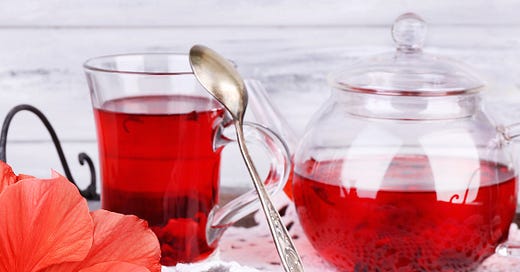Hibiscus Tea and its Cardiovascular Health Benefits
A hidden gem many herbalists miss, the research is here.
I love cold-brewing hibiscus tea in the summertime—just two tablespoons in a small pitcher of filtered water, left to steep in the fridge overnight. The result is bright, tart, and refreshing, with or without a touch of honey.
Until recently, I never considered its health benefits. But as I began reading more about hibiscus, both for its wellness properties and culinary charm, I was surprised to find almost nothing in my trusted herbal references. Even Memorial Sloan Kettering’s usually thorough Integrative Medicine Botanical database had no listing.
Then I realized hibiscus is a staple of Ayurvedic and Traditional Chinese Medicine. Turning to my Ayurvedic resources, I found what I had been missing: a more holistic understanding that embraces the plant's physical and energetic qualities, not just its clinical uses.
Hibiscus (H. sabdariffa) is commonly called roselle. It is also called Jamaica, red sorrel, Indian sorrel, wonjo, japa, and karkade. Although native to India and Malaysia, hibiscus is widely distributed and cultivated worldwide in tropical and subtropical regions, including China, Thailand, Indonesia, Egypt, Sudan, Saudi Arabia, Taiwan, Vietnam, Nigeria, and Mexico.
The American Botanical Society has been reporting the antihypertensive properties of hibiscus for many years:
Hibiscus sabdariffa is a member of the mallow family (Malvaceae) and is believed to have originated in Middle Africa in the area that is now Angola. The calyx (the structure around the petals) is the primary plant part used, specifically in teas for lowering blood pressure and for its cooling effect. All the above-ground parts of the hibiscus plant, including the stem, leaves, calyces, and seeds, are used for food, fiber, or medicine. 1
Today, hibiscus is well known for its antibacterial, antioxidant, anticholesterol, antidiabetic, and antihypertensive effects. That’s quite a promising flower since blood pressure and glycemic control are two major risk factors for heart disease.
Although hibiscus has been used for centuries as a folk medicine, just twenty years ago, little scientific evidence supported these claims. But today, there is much more research. Let’s see how we can benefit from hibiscus, where to buy organic hibiscus, and how we can use our food as medicine.




